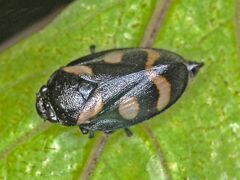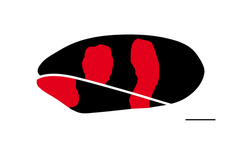Biology:Cercopis sanguinolenta
| Cercopis sanguinolenta | |
|---|---|

| |
| Upperside | |

| |
| Side view | |
| Scientific classification | |
| Domain: | Eukaryota |
| Kingdom: | Animalia |
| Phylum: | Arthropoda |
| Class: | Insecta |
| Order: | Hemiptera |
| Suborder: | Auchenorrhyncha |
| Family: | Cercopidae |
| Genus: | Cercopis |
| Species: | C. sanguinolenta
|
| Binomial name | |
| Cercopis sanguinolenta (Scopoli, 1763)
| |
| Synonyms | |
| |
Cercopis sanguinolenta is a species of cicadas in the family Cercopidae.
Distribution and habitat
This species mainly occurs in southern Europe up to Caucasus and the Near East.[1] These froghoppers inhabit dry, sunny slopes and herbaceous rich clearings.
Description
Cercopis sanguinolenta can reach a length of 6–11 millimetres (0.24–0.43 in).[2] The male is larger than the female.[3] These froghopper are shining black with bright red marks on the elytra, one spot at the base, one spot in the middle and a stripe at the apex.[4]
Bodies in dorsal view are elongated and ovoid. The head is much narrower than the pronotum. Legs are always completely black. Very rarely, red marks are reduced or even missing, and such specimens are almost completely black. The adults of Cercopis, just after getting free from the nymphal exuvia, show pink or whitish markings instead of blood-red.[5]
This species is very similar to Cercopis vulnerata, but its red stripes are smaller[2] and the rear stripe is only slightly curved, while in Cercopis vulnerata it is U-shaped. Cercopis sanguinolenta also has a few black spots on the ventral plates of the connexivum, the lateral border of the abdomen.[6][7]
Biology
Adults can be seen in May through July or August[2] on herbaceous plants and shrubs, mainly in meadows and woodland edges. It feeds on the sap of the plants. It can fly, but it more often moves by jumping.
When they mate Cercopis male and female stay side by side with an angle of less than 45°.[2]
Larvae live surrounded by their own secretions in a sort of foam nest and suck the juices on the roots of the host plants.
Gallery
References
- ↑ Fauna europaea
- ↑ 2.0 2.1 2.2 2.3 Soortenbank (in Dutch)
- ↑ Biedermann, R. (2002). "Mating success in the spittlebug Cercopis sanguinolenta (Scopoli, 1763) (Homoptera, Cercopidae): the role of body size and mobility". Journal of Ethology 20 (1): 13–18. doi:10.1007/s10164-002-0048-9.
- ↑ The Edinburgh Encyclopædia; Conducted by David Brewster, Volume 9
- ↑ "Cercopis arcuata, Emilia Romagna". https://www.naturamediterraneo.com/forum/topic.asp?TOPIC_ID=139878.
- ↑ Key of Cercopis species at Biodiversidat virtual (in Spanish)
- ↑ Key at The Auchenorrhyncha of Central Europe - Die Zikaden Mitteleuropas
External links
| Wikimedia Commons has media related to Cercopis sanguinolenta. |
- Biolib
- Catalogue of life
- Adeline Soulier-Perkins Cercopoidea Organised On Line Paris Universitas
Wikidata ☰ Q5063962 entry
 |




